Monthly Updates on Recent Books in the History of Christianity
To raise awareness of recent books in the history of Christianity, the editorial staff of Church History: Studies in Christianity and Culture highlights each month a list of 10-15 books in diverse periods and geographical regions that we hope will be of interest to our members. We include here below the 46th monthly list, chosen by our staff, with excerpts from the publishers’ blurbs.
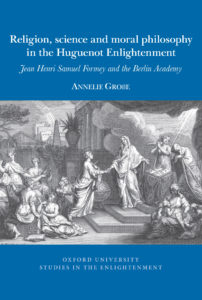
Annelie Große, Religion, Science and Moral Philosophy in the Huguenot Enlightenment: Jean Henri Samuel Formey and the Berlin Academy. 2024
Religion, Science and Moral Philosophy in the Huguenot Enlightenment makes two significant contributions to existing scholarship on the Enlightenment. Firstly, as an author, journalist, translator, and inexhaustible letter writer, the Huguenot pastor and secretary of the Berlin Academy of Science, Samuel Formey, was involved in most of the philosophical debates in the European Republic of Letters during the second half of the eighteenth century. This is the first monograph dedicated solely to Formey’s multifaceted work. Secondly, the book recasts the concept of Religious Enlightenment by considering Formey as a pastor-philosopher whose concept of philosophy included revealed religion instead of perpetuating the image of him as an ‘enemy of Enlightenment’ who opposed the philosophy of his time by referring to religion.
More precisely, the book explores the notion of the compatibility between reason and faith in Formey’s thought on the existence of God, the freedom of will, divine providence and other questions relating to religion and metaphysics. It shows how Formey altered his portrayal of the relation between reason and faith depending on the genre and immediate context of his writings. The broader contextualisation of Formey’s arguments in German rationalist philosophy and Calvinist theology unveils not only the overlaps between Wolffianism and eighteenth-century Calvinism but also gives an impression of the diversity of the thought of Huguenot pastors and philosophers during the Enlightenment.
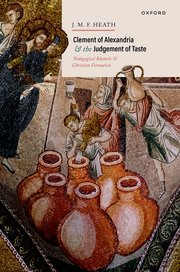
J. M. F. Heath, Clement of Alexandria and the Judgement of Taste: Pedagogical Rhetoric and Christian Formation. 2024
This book gives an account of Clement of Alexandria’s Paedagogus as a programme in the formation of the judgement of taste, and puts this in critical dialogue with some modern approaches to the judgement of taste and aesthetics. Its questions are framed in light of Pierre Bourdieu’s Distinction, which was a landmark in 20th century scholarship on the theory of taste. However, I seek answers based on a study of Clement’s rhetoric and theology in the context of the Christian Second Sophistic, when Christians were experimenting with new ways of inhabiting the rhetorical and philosophical culture in the Greco-Roman world. The Paedagogus manifests Clement’s pedagogical method and rhetorical strategy at the early stages of Christian formation, when his audience are not yet ready for abstract philosophical argument. This was a time for forming their habits of judgement and preferences of ‘taste’, so as to ground preferences in daily life in deeper desires and aversions that are structured through relationship with God. This was an immensely important stage of formation: many people never got beyond this to the philosophical curriculum, and yet through engaging the ‘tastes’ of a wide audience, Christian leaders sought to spread the gospel, and indeed succeeded in doing so. Even for the intellectual elites, personal formation through preferences of taste was part of how they embodied their desire for God in this life, and the way they inhabited it through the sacramental and ascetic life of the church. Bourdieu’s sociological and anthropological approach proves fruitful for understanding aspects of Clement’s rhetorical method and purpose, but the study of Clement’s theological rhetoric in its cultural context points the way to a theological response to Bourdieu’s theory of taste.
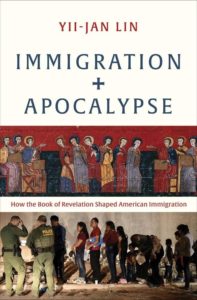
Yii-Jan Lin, Immigration and Apocalypse: How the Book of Revelation Shaped American Immigration. 2024
America appeared on the European horizon at a moment of apocalyptic expectation and ambition. Explorers and colonizers imagined the land to be paradise, the New Jerusalem of the Bible’s Book of Revelation. This groundbreaking volume explores the conceptualization of America as the New Jerusalem from the time of Columbus to the Puritan colonists, through U.S. expansion, and from the eras of Reagan to Trump.
While the metaphor of the New Jerusalem has been useful in portraying a shining, God-blessed refuge with open gates, it has also been used to exclude, attack, and criminalize unwanted peoples. Yii-Jan Lin shows how newspapers, political speeches, sermons, cartoons, and novels throughout American history have used the language of Revelation to define immigrants as God’s enemies who must be shut out of the gates. This book exposes Revelation’s apocalyptic logic at work in the history of Chinese exclusion, the association of the unwanted with disease, the contradictions of citizenship laws, and the justification for building a U.S.-Mexico wall like the wall around the New Jerusalem.
This book is a fascinating analysis of the religious, biblical, and apocalyptic in American immigration history and a damning narrative that weaves together American religious history, immigration and ethnic studies, and the use of biblical texts and imagery.
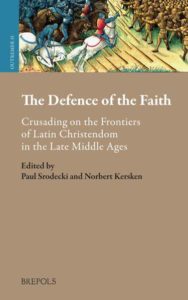
Paul Srodecki and Norbert Kersken, eds. The Defence of the Faith: Crusading on the Frontiers of Latin Christendom in the Late Middle Ages. 2024
This volume focuses on the complex and often overlooked topic of crusading activities and the crusade movement on the fringes of Latin Christendom in the time frame from approximately 1300 to the beginning of the sixteenth century. It covers a period widely considered as a time of significant political, cultural and religious changes in Europe. A period in which Western Christianity was on the one hand still expanding (vide Lithuania and the western Rus and later the Spanish, Portuguese, French and English expansion in the Americas, Africa and South-East Asia) and on the other hand facing two mighty opponents: the Ottoman Empire and Muscovy. On its eastern and southeastern frontiers, Latin Christian expansion came to a gradual halt — here, the West was now largely under siege! Alone the political, logistical and ultimately also military feasibility of a large-scale crusade to liberate Jerusalem had now receded into a purely theoretical and practically almost unenforceable far distance. Ranging in scope from the Baltic Sea region to the Balkans and Iberia, this book’s nineteen papers explore how these developments influenced the continuation and adaptation of crusading ideas and activities during this later period of crusades.
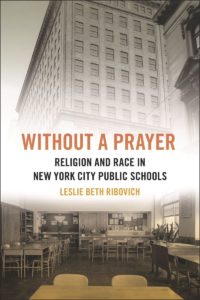
Leslie Beth Ribovich, Without a Prayer: Religion and Race in New York City Public Schools. 2024
The processes of secularization and desegregation were among the two most radical transformations of the American public school system in all its history. Many regard the 1962 and 1963 US Supreme Court rulings against school prayer and Bible-reading as the end of religion in public schools. Likewise, the 1954 Brown v. Board of Education case is seen as the dawn of school racial equality. Yet, these two major twentieth-century American educational movements are often perceived as having no bearing on one another.
Without a Prayer redefines secularization and desegregation as intrinsically linked. Using New York City as a window into a national story, the volume argues that these rulings failed to successfully remove religion from public schools, because it was worked into the foundation of the public education structure, especially how public schools treated race and moral formation. Moreover, even public schools that were not legally segregated nonetheless remained racially segregated in part because public schools rooted moral lessons in an invented tradition—Judeo-Christianity—and in whiteness.
The book illuminates how both secularization and desegregation took the form of inculcating students into white Christian norms as part of their project of shaping them into citizens. Schools and religious and civic constituents worked together to promote programs such as juvenile delinquency prevention, moral and spiritual values curricula, and racial integration advocacy. At the same time, religiously and racially diverse community members drew on, resisted, and reimagined public school morality.
Drawing on research from a number of archival repositories, newspaper and legal databases, and visual and material culture, Without a Prayer shows how religion and racial discrimination were woven into the very fabric of public schools, continuing to inform public education’s everyday practices even after the Supreme Court rulings.
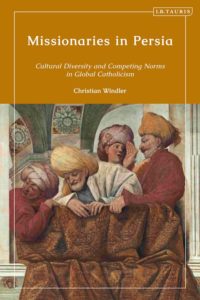
Christopher Windler, Missionaries in Persia: Cultural Diversity and Competing Norms in Global Catholicism. 2024
In the seventeenth and eighteenth centuries, Isfahan, the capital of the Safavid Empire, hosted Catholic missionaries of more diverse affiliations than most other cities in Asia. Attracted by the hope of converting the Shah, the missionaries acted as diplomatic agents for Catholic rulers, hosts to Protestant merchants, and healers of Armenians and Muslims. Through such niche activities they gained social acceptance locally. This book examines the activities of Discalced Carmelites and other missionaries, revealing the flexibility they demonstrated in dealing with cultural diversity, a common feature of missionary activity throughout emerging global Catholicism. While missions all over the world were central to the self-fashioning of the Counter-Reformation Church, clerics who set out to win over souls for the “true religion” turned into local actors who built reputations by defining their social roles in accordance with the expectations of their host society. Such practices fed controversies that were fought out in newly emerging public spaces. Responding to the threat this posed to its authority, the Roman Curia initiated a process of doctrinal disambiguation and centralization which culminated in the nineteenth century. Using the missions to Safavid Iran as a case study for “a global history on a small scale,” the book creates a new paradigm for the study of global Catholicism.
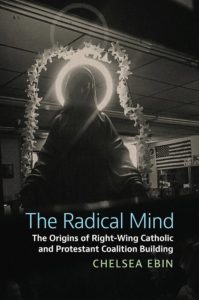
Chelsea Ebin, The Radical Mind: The Origins of Right-Wing Catholic and Protestant Coalition Building. 2024
The Radical Mind is a groundbreaking analysis of the origins of the Christian Right, whose political victories are radically reshaping the landscape of American society. Scholars and the public alike have traditionally regarded the New Right and the Christian Right as separate movements. The New Right is supposedly a secular right-wing operation with purely political goals, while the Christian Right is an evangelical Protestant movement largely motivated by religious convictions. Insofar as both are conservative efforts, most people view them as reactionary and driven by a culture-war backlash against liberal changes to society.
Chelsea Ebin’s The Radical Mind aims to overturn this consensus. Through a close analysis of New Right architects Connaught Marshner and Paul Weyrich (who is often seen as secular but was a committed Catholic), this book explores the way conservative Catholics and Protestants overcame their long-standing antipathy to form a political coalition—what Ebin calls the New Christian Right. Drawing on extensive archival research, Ebin shows how the movement’s key architects infused right-wing activism with religion. Rather than working to conserve the past, this book argues that the New Christian Right is fundamentally a forward-looking and proactive movement focused on remaking the political landscape in the United States.
The radical aims of the New Christian Right have been obscured by the way they cultivated a shared identity of victimhood and manipulated the discourse about backlash to create a nostalgic idea of the past that they then leveraged to justify their right-wing policy goals. The Catholic-Protestant alliance constructed an imagined past that they projected into the future as their ideal vision of society. Ebin calls this strategy “prefigurative traditionalism”—a paradoxical prefiguring of a manufactured past. Using this tactic, the New Christian Right coalition disguised the radicality of its politics by framing their aims as reactionary and defensive rather than proactive and offensive.
An interdisciplinary work informed by the fields of history, religious studies, public law, and American politics, The Radical Mind offers a new and convincing explanation for the recent gains of the Christian Right and the morally supercharged political landscape we face today.
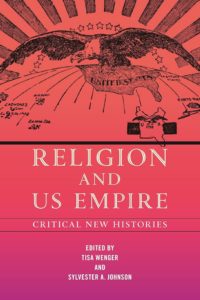
Tisa Wenger and Johnson Sylvester A., eds. Religion and US Empire: Critical New Histories. 2024
The United States has been an empire since the time of its founding, and this empire is inextricably intertwined with American religion. Religion and US Empire examines the relationship between these dynamic forces throughout the country’s history and into the present. The volume will serve as the most comprehensive and definitive text on the relationship between US empire and American religion.
Whereas other works describe religion as a force that aided or motivated American imperialism, this comprehensive new history reveals how imperialism shaped American religion—and how religion historically structured, enabled, challenged, and resisted US imperialism. Chapters move chronologically from the eighteenth century to the twenty-first, ranging geographically from the Caribbean, Michigan, and Liberia, to Oklahoma, Hawai’i, and the Philippines. Rather than situating these histories safely in the past, the final chapters ask readers to consider present day entanglements between capitalism, imperialism, and American religion. Religion and US Empire is an urgent work of history, offering the context behind a relationship that is, for better or worse, very much alive today.
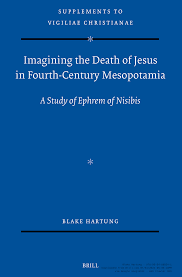
Blake Hartung, Imagining the Death of Jesus in Fourth-Century Mesopotamia. 2023
In this volume Blake Hartung explores the place of the passion and death of Jesus in the writings of Ephrem of Nisibis (ca. 307–373). The book argues that the genre of Ephrem’s works (usually short poems for public performance), is key to understanding his unsystematic approach. Ephrem drew widely upon the Passion narratives and traditional motifs related to Christ’s death and deployed them differently in distinct settings. Each chapter explores a key theme in Ephrem’s discourse about the death of Christ in context (including anti-Judaism, the defeat of death, and economic imagery). Ultimately, Hartung urges further consideration of the role of Christ’s death in early Christian thought and practice beyond the traditional confines of atonement theology.
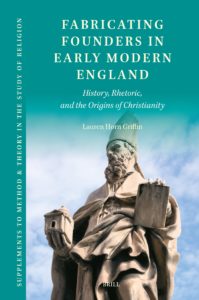
Lauren Horn Griffin, Fabricating Founders in Early Modern England: History, Rhetoric, and the Origins of Christianity. 2023
This book argues that in order to understand nationalisms, we need a clearer understanding of the types of cultural myths, symbols, and traditions that legitimate them. Myths of origin and election, memories of a greater and purer past, and narratives of persecution and mission are required for the production and maintenance of powerful national sentiments. Through an investigation of how early modern Catholics and Protestants reimagined, reinterpreted, and rewrote the lives of the founder-saints who spread Christianity in England, this book offers a theoretical framework for the study of origin narratives. Analyzing the discursive construction of time and place, the invocation of forces beyond the human to naturalize and authorize, and the role of visual and ritual culture in fabrications of the past, this book provides a case study for how to approach claims about founding figures. Serving as a timely example of the dependence of national identity on key religious resources, Griffin shows how origin narratives – particularly the founding figures that anchor them – function as uniquely powerful rhetorical tools for the cultural production of regional and national identity.

David Golding and Christopher Cannon Jones, eds. Missionary Interests: Protestant and Mormon Missions of the Nineteenth and Twentieth Centuries. 2024
In Missionary Interests, David Golding and Christopher Cannon Jones bring together works about Protestant and Mormon missionaries in the nineteenth and twentieth centuries, charting new directions for the historical study of these zealous evangelists for their faith. Despite their sectarian differences, both groups of missionaries shared notions of dividing the world categorically along the lines of race, status, and relative exoticism, and both employed humanitarian outreach with designs to proselytize.
American missionaries occupied liminal spaces: between proselytizer and proselytized, feminine and masculine, colonizer and colonized. Taken together, the chapters in Missionary Interests dismantle easy characterizations of missions and conversion and offer an overlooked juxtaposition between Mormon and Protestant missionary efforts in the nineteenth and twentieth centuries.
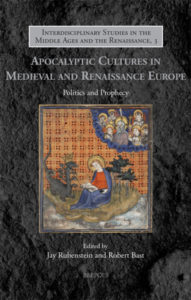
Jay Rubenstein and Robert Bast, eds. Apocalyptic Cultures in Medieval and Renaissance Europe. 2024
The essays in this collection were presented at the 2020 Symposium on Apocalypticism, sponsored by the Marco Institute for Medieval and Renaissance Studies at the University of Tennessee. The authors offer new readings of medieval and Renaissance Apocalypticism in quotidian terms, not as ‘counterculture’ but as the pragmatic expression of spiritualities that informed both debate and practice, on subjects as mundane and diverse as warfare, pilgrimage, gender, cartography, environmentalism, and governance. Topics include the origins of imperial eschatology; reflections on cosmology and the fate of the earth; the fusion of history, prophecy, and genealogy; Joachite readings of the political landscape of Italy; the influence of the Great Schism on Burgundian art; eschatology and gender in pilgrimage literature; the late medieval interpretation of the Revelationes of Pseudo-Methodius; and the appropriation of apocalyptic tropes in the propaganda and policies of the German emperor Maximilian I. The essays that open and close this collection offer meditations on the enduring legacy of Apocalypticism by focusing on the events — pandemic, political unrest, and the proliferation of conspiracy theories manifest in both — that mark the historical era in which this symposium took place.
Finally, for staying up-to-date on the latest titles in all fields, we recommend regularly perusing New Books Network and its "New Books in Christian Studies” page. These pages are updated regularly.
